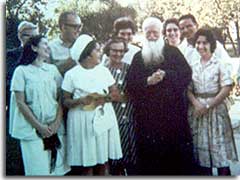 |
| Jesús M. Pagán
(second from L to R in back row) with Father Kentenich and pilgrims.
Jesús M. Pagán (segundo de I a D en la fila de atrás) con el Padre Kentenich y peregrinos. Jesús M. Pagan (zweiter von links in der hinteren Reihe) mit Pater Kentenich und Pilgern. |
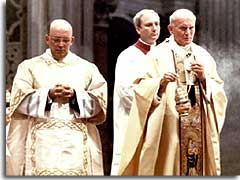 |
| Deacon Pagán
with the Holy Father. Diácono Pagán con el Santo Padre. Diakon Pagán mit dem Heiligen Vater. |
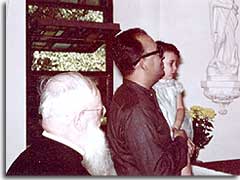 |
| Jesús Pagán
with his daughter and Father Kentenich at the Exile Shrine. Jesús Pagán con su hija y el Padre Kentenich en el Santuario del Exilio. Jesús Pagán mit seiner Tochter und Pater Kentenich im Exilheiligtum. |
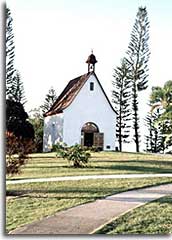 |
| Shrine of
Solidarity, Cabo Rojo, Puerto Rico Heiligtum der Solidarität, Cabo Rojo, Puerto Rico |
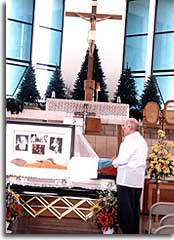 |
| Deacon Pagán
at the Pilgrims' Center, Cabo Rojo, PR. El diácono Pagán en el Centro de Peregrinos, Cabo Rojo, PR Diakon Pagán im Pilgerzentrum Cabo Rojo, Puerto Rico |
| Fotos: Pérez, Puerto Rico © 2001 |
Brief Introduction: Schoenstatt and Puerto Rico
In the years of the sixties, Puerto Rican residents in New York, started learning about Schoenstatt through Pallottine Fathers (Fr. Carlos Boskamp, and Fr. Juan Sartor) that were exercising their pastoral work in Brooklyn, NY. Time later, the first pilgrims (Mrs. Luisa Aguayo and Mrs. Filomena Calderón) left to Milwaukee to meet Fr. Kentenich. Later followed by more Puerto Ricans like Mr. and Mrs. Jesús M. Pagán. All were fascinated and attracted by the personality of Father Kentenich, a Marian and paternal personality. These same Puerto Ricans, with their enthusiasm, were the ones that took Schoenstatt later on to the island of Puerto Rico, transmitting their enthusiasm to many. Among them, Jesús and Hilda Pagán with their return to the island in 1967.
With time, the movement grew in Puerto Rico with the help of many, among them Fr. Carlos Boskamp and Fr. Juan Sartor (by then Schoenstatt Fathers). Fr. Juan Sartor was assigned to the parish in Barranquitas. In September 1970, Fr. Guillermo Esters, from the Institute of the Schoenstatt Priests, arrived to the island. In February 1971, Sr. Petra Schnuerer arrived, and the Community of the Sisters of Mary was officially established in the island. After many difficulties and sacrifices, on July 7, 1973, the first Daughter Shrine, the Shrine of Solidarity, was dedicated in Cabo Rojo.
Today, there are two more Daughter Shrines: Cenacle of the Immaculate in Juana Díaz (Diocese of Ponce) and the Shrine of the Slaves of the Eucharist and the Virgin Mary in Hatillo. The movement kept on growing and has members in different branches: League of Priests, Institute of Schoenstatt Priests, Girls' Youth, Women’s League, Mothers’ League, Women’s Federation, Mothers’ Federation, Sisters of Mary, Family League, Couples’ Federation and Institute of Families. There has been Boys' Youth, but it has not been active in the last years.
Memoir Remarks on Jesús María Pagán (IX/25/1937 – I/17/2001)
Jesús María Pagán was born in an island with abundant palm trees, "flamboyan" trees, birds’ chirps, countless and colorful flowers, sea, rivers, songs and poetry. Jesús was born in the tropical Caribbean island of Puerto Rico.
A few years after his marriage, he moves to New York. There, he and his wife, Hilda, hear about Schoenstatt and Fr. Kentenich who lives in Milwaukee, Wisconsin. Their curiosity about this father is so great that they decide to travel to Milwaukee to meet him in the very early sixties. Jesús would make two more trips by himself and on the third visit, Father Kentenich invites them to move to Milwaukee. In less than a month, the young and idealist couple moves and follows Father Kentenich's steps. Father Kentenich – a man with his feet on the ground and thoughts in Heaven – just captivated them.
Jesús found a job as an occupational therapist in an institute for children. After a while, the position of a caretaker for the Pallottine Fathers’ house showed up. Also, the availability of a house, property of the Pallottine Fathers, close to the Exile Shrine. Jesús shared his idea to apply for the job to Father Kentenich. He agreed with Jesús. Jesús talked with the rector. He was surprised that Jesús was interested in cleaning floors on a part time basis if he had already a professional job. The rector accepted and in exchange offered him the house available close to the Shrine.
"It was Heaven of Earth"
The Pagán family visited the Shrine of the Exile with Father Kentenich on many occasions. They took part in the Monday Night Talks that Father Kentneich gave for couples. Father Kentenich visited their home many times during the last period of his exile when he could not receive visits in his office. Father Kentenich would receive his visitors at the Pagáns’ home. This home became a nest for Father Kentenich. Jesús and Hilda would say: "It was Heaven on earth." (1) Every Friday, they would go to confession with Father Kentenich, and received frequently spiritual counseling in his office. Jesús served as a translator to Father Kentenich on many occasions. Father Kentenich prepared him so that he could pass on the Schoenstatt essential elements to others.
They had a relationship with Father Kentenich as a couple, as a family and as a Latin-American family. Father Kentenich transformed in them the ingenuity that characterizes the Latin-Americans into childlikeness. Father Kentenich trusted and loved them. "…until the three of us loved each other not only infinitely, but in an extraordinary close, personal and affective way." (2) Father Kentenich let himself being loved by them and he loved them tenderly. Father Kentenich never hid his affection for them and gave them as many gifts as he could. "I never felt afraid to come close to Father Kentenich, to talk with him and touch any topic. If there is anything that I have never been sorry of is not to have wasted a minute of been close to him… I always felt welcome by Father Kentenich."(3)
"This is a True Home Shrine"
On October 18, 1963, they crowned the Blessed Mother. They allocated a whole room of their home to the Blessed Mother. Father Kentenich said on this occasion, "This is a true Home Shrine."
There were many visits that Jesús made to Father Kentenich late at night to deal exclusively with spiritual matters. If not, through the phone and they would talk for long… Many times after a conversation, Father Kentenich would tell them: "More and more we are becoming a family" (4), referring to Jesús, Hilda, the children and himself.
No other family was so close to Father as they were. Father Kentenich trusted them so much that he would share with them his joys and sorrows. In difficult times, because of Jesús’ job cleaning floors at the Pallottine house at night, he became a "clandestine" bearer to Father of letters and messages in or out of the house.
Representing Schoenstatt on the Mariological and Marian Congress
In fall of 1964, an invitation to the Mariological and Marian Congress at Santo Domingo, Dominican Republic was received. The congress was going to be held on March 1965. Father Kentenich invited Jesús to represent the Schoenstatt Family. Father Kentenich wrote the presentation himself. Jesús was the only lay speaker. After the congress, on his way back to Milwaukee, he stopped over at his parents’ home in Aguadilla, PR. It is in his parents’ home that Fr. Carlos Boskamp dedicated the first Home Shrine in Puerto Rico.
His "Mission of May 31" – Sharing Father Kentenich's Mission
Before leaving to the congress, Father Kentenich said to Jesús: "…your mission is to preach the mission of May 31." (5) For Jesús, this was a sending act. Years later, in 1991, when he was in a workshop for the preparation to the Golden Jubilee of January 20 in Florencio Varela, Buenos Aires, Argentina, Jesús felt an internal inspiration while he was praying at the Shrine: "Preach, preach incessantly the name of Father Kentenich. When you do that, you will be preaching the name of Christ because Father Kentenich was a transparency of God’s paternity and God was made perfectly transparent through his Son Jesus Christ. This is for you the mission of May 31, to preach the greatness of Mary through the person of Father Kentenich." (6) Thus, he proclaimed Father Kentenich and his mission more vehemently than before.
On September 15, 1973, he was ordained permanent deacon in the diocese of Ponce, PR. He felt a great joy to be able to serve God, and to serve Father Kentenich's mission, in this new way.
Schoenstatt – Heart of the Church
In the eighties, at the end of the celebration of the Marian year in Rome, Jesús was an assisting deacon to the Holy Father during the Holy Mass. He confided to a friend that being at the side of the Holy Father he felt "that symbolically it was true that Schoenstatt was in its humility and smallness, in its silent and deacon service like Mary, heart of the Church." (7)
Eight minutes before leaving to the Eternal Schoenstatt, he wrote his last words: "To you two – three, my blessing and a kiss." Interpreted by many as: "To all, my blessing and a kiss."
Jesús María Pagán died in an island with abundant palm trees, "flamboyan" trees, birds’ chirps, countless and colorful flowers, sea, rivers, songs and poetry. He was buried behind the Shrine of Solidarity in Cabo Rojo, very close to Father Kentenich's memorial. For us, the Schoenstatt Family, it is a blessing that he rests in this holy place that he loved so much.
I knew deacon Pagán and have vivid memories of him and Mrs. Pagán. I felt his love for the Church, the Blessed Mother, Schoenstatt, Father, the family. He talked with great conviction of family values. I saw his devotion, sacrifices, faithfulness and childlikeness towards Father. I felt truly and touchingly the presence of Father at his Home Shrine. This work would have been very long if I would tell some of my experiences with the Pagán Family. I only wanted to present to you the figure of deacon Pagán and his importance in the Schoenstatt history for the lay people, specially for the married couples that want to live close to Father Kentenich.
Thanks
I want to thank Mrs. Hilda Pagán for her support on this work, for the conversation that we held on the phone that gave me strength to make this writing a reality and for sharing family pictures with me. To Fé and Fred Pérez, of the Couples’ Federation, from Cabo Rojo, PR, who sent me the pictures of Mrs. Pagán, the funeral and the burial. To Sr. M. Kornelia who asked me to write this article which has been an honor to me. To Fr. Hector R. Vega who has accompanied me with his prayers and support during the preparation and realization of it. To you all, my gratitude and prayers. God bless you!
Mercedes I. Vivoni, Institute of Families, Arlington, Texas USA
Notes
(1), (2), (3), (4), (5) and (6) Pagán, Jesús M., Letter to Family Anita and Alfredo Moore, members of the first Chilean course of the Institute of Families, 08/22/1993.
(7) Coeymans, Juan
Enrique and Zabala, Carmen, Letter to the Schoenstatt Family (sent to
me via e-mail), Chile, 01/18.2001.